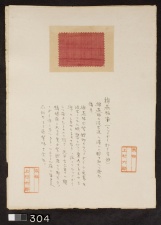Difference between revisions of "Lac-dye - center (304 C)"
Jump to navigation
Jump to search
(username removed) |
(username removed) |
||
| Line 5: | Line 5: | ||
| 304 | | 304 | ||
|- | |- | ||
| − | ! scope="row"| | + | ! scope="row"|Uemura number / title |
| − | | | + | | ; "Haze-some 25" |
|- | |- | ||
! scope="row"|Folder location | ! scope="row"|Folder location | ||
| Line 44: | Line 44: | ||
| vinegar | | vinegar | ||
|- | |- | ||
| − | ! scope="row"| | + | ! scope="row"|Uemura's notes |
| − | | The Enji-wata ( | + | | The Enji-wata () a cotton wool containing extracted dye compounds of lac dye and alum. The resultant colors of those dyed with this extract and those with the raw material would be similar. (Kirinketsu-zome) recorded in a manuscript from the Tempyo period (8th century AD), Japan is considered to be a dyeing technique with lac dyes. The resultant color was similar to that of cochineal dyeing, but was more purple. |
|- | |- | ||
| − | ! scope="row"| | + | ! scope="row"|Uemura's date |
| Kyoto | | Kyoto | ||
|} | |} | ||
| − | [[Category: | + | [[Category:Uemura dye archive]] |
Latest revision as of 06:20, 24 July 2013
| Museum number | 304 |
|---|---|
| Uemura number / title | ; "Haze-some 25" |
| Folder location | 4th shelf |
| Sample location | center (304 C) |
| Fiber type | silk |
| Color | reddish pink |
| Dyestuff (Japanese common name) | ラックダイ : Lac-dye |
| Dye (English common name) | Lac dye |
| Dyestuff (botanical name) | resinous secretion developed by the scale insect Kerria lacca |
| Plant part | Extracted dye compounds and alum absorbed in cotton batting |
| Dyestuff extraction | soaked in water |
| Auxiliary agent in dye bath | - |
| Mordant | alum (originally contained in the dye extract) |
| Other auxiliary agent | vinegar |
| Uemura's notes | The Enji-wata () a cotton wool containing extracted dye compounds of lac dye and alum. The resultant colors of those dyed with this extract and those with the raw material would be similar. (Kirinketsu-zome) recorded in a manuscript from the Tempyo period (8th century AD), Japan is considered to be a dyeing technique with lac dyes. The resultant color was similar to that of cochineal dyeing, but was more purple. |
| Uemura's date | Kyoto |
